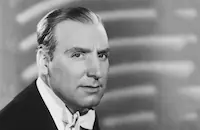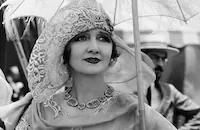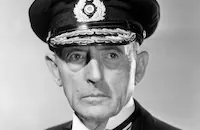Little Man, What Now?
Brief Synopsis
Cast & Crew
Frank Borzage
Margaret Sullavan
Douglass Montgomery
Alan Hale
Catharine Doucet
Dewitt Jennings
Film Details
Technical Specs

Synopsis
Hans Pinneberg is a young German clerk, who, in the troubled economic times, wants only to accept life peacefully. He and his sweetheart, Emma Merceau, whom he affectionately calls "Lammchen," marry after they confirm that she is pregnant. Hans brings Lammchen to his town but keeps their marriage secret because his boss, autocratic corn merchant Emil Kleinholz, employs only unmarried clerks, as he is looking for a husband for his immature daughter Marie. After Marie chooses Hans, the whole Kleinholz family, out for a Sunday outing, see Hans and Lammchen kissing in the park, and Hans quits when Kleinholz insults Lammchen. After three weeks of unemployment pass, Lammchen writes to Hans's stepmother Mia in Berlin, who answers promising Hans a job in a clothing store. In Berlin, they find Mia living with Holger Jachman, an underworld bon vivant , who develops an interest in Lammchen. Through Jachman's influence, Hans gets work as a salesman, but he spends most of his first salary on an expensive dressing table, which Lammchen has admired, rather than paying Mia for rent. However, during a party, Jachman, intoxicated, leaves 200 marks for the rent before passing out. When the store institutes a policy of paying salesmen on a percentage basis, Herr Heilbutt, the head salesman and a nudist whom Hans has come to like, resigns in protest. After Hans's colleague Kessler snidely informs him that Mia uses the apartment to introduce "lonely men to lovely women," Hans breaks up a breakfast party and takes Lammchen away from the apartment. They are offered a room by kindly furniture hauler Herr Puttbreese, but Hans loses his job after insulting screen actor Franz Schlüter, a customer who has used two hours of Hans's time without buying anything. After Jachman invites Hans and Lammchen to an expensive cafe and gets nowhere flirting with Lammchen, the police finally catch up with him and arrest him, leaving Hans and Lammchen with the bill, but an envelope from Jachman then arrives containing more than enough money to cover it. When Lammchen goes into labor, Herr Puttbreese takes her to the hospital because Hans cannot be found. After Hans is involved in a street riot, he comes home ashamed to look Lammchen in the face, but after seeing his son, Hans is encouraged to take care of him. Lammchen reminds Hans that "we created life, so why be afraid of it," and after Heilbutt arrives with a job offer for Hans in Amsterdam, the baby yawns amidst the adults' celebration.

Director

Frank Borzage
Cast

Margaret Sullavan

Douglass Montgomery

Alan Hale
Catharine Doucet

Dewitt Jennings
G. P. Huntley Jr.
Muriel Kirkland
Fred Kohler

Mae Marsh
Donald Haines

Christian Rub

Alan Mowbray

Hedda Hopper
Sarah Padden
Earle Foxe

George Meeker
Bodil Rosing

Monroe Owsley

Paul Fix
Carlos De Valdez
Thomas Ricketts

Frank Reicher

Etienne Girardot
Max Asher
Torben Meyer
Bert Roach
Roger Cluett
Al Taylor
William Augustin
Robert Graves
William Norton Bailey
Helen Dickson
Lowell Drew
Anders Van Haden
Ed Hart
Fritzi Ridgeway
John Ince
Russ Powell
Jeanne Hart
Hallam Cooley
Robert Agnew
Edward Phillips

Jack Mower
Crew
James Atherton
Frank Borzage
Lew Borzage
Norbert Brodine
Milton Carruth
William Ely
John Gates
Charles D. Hall
Henry Henigson
C. Roy Hunter
Arthur Kay
Gilbert Kurland
Carl Laemmle Jr.
Carl Laemmle
William Anthony Mcguire
M. F. Murphy
Cora Palmatier
Sergei Petschnikoff
Maurice Pivar
R. C. Sherriff
Jo Swerling

Film Details
Technical Specs

Quotes
Trivia
Notes
The novel by Hans Fallada (pseud. of Rudolf Ditzen) was published in an English-language translation in New York in 1933. Variety noted that the book was the best selling novel of 1933. According to a news item, director Frank Borzage used the largest inside set ever constructed at Universal for the Berlin arrival sequence, in which 400 extras appeared. While the screen credits read "Produced by Carl Laemmle, Jr.," the Screen Achievements Bulletin lists Henry Henigson as producer and Carl Laemmle, Jr. as executive producer. According to a news item, the scene in the park in which "Lammchen" and "Hans" lie on the ground was considered objectionable for Sunday showings in Massachusetts, and that scene along with some others were cut in Ohio. This film was included in the Legion of Decency's list of condemned films. In a modern interview, Edgar G. Ulmer states that he "sold" Carl Laemmle, Jr. on the idea to make the film and that he designed the sets. Modern sources list the following additional credits: Assistant Camera William Dodds; Makeup Jack P. Pierce. A 1933 German film based on the same source, entitled Kleiner Mann, was nun?, was directed by Fritz Wendhawen and starred Hermann Thimig and Hertha Thiele. In 1966, an East German television feature based on the same source was produced, which was directed by Hans Joachim Kasprzik and starred Arno Wysniewski and Jutta Hoffmann. in 1933.

Miscellaneous Notes
Released in United States 1934
Released in United States 1997
Released in United States 1934
Released in United States 1997 (Shown in New York City (Walter Reade) as part of program "American Romantics: Frank Borzage and Margaret Sullavan" August 22 - September 16, 1997.)











